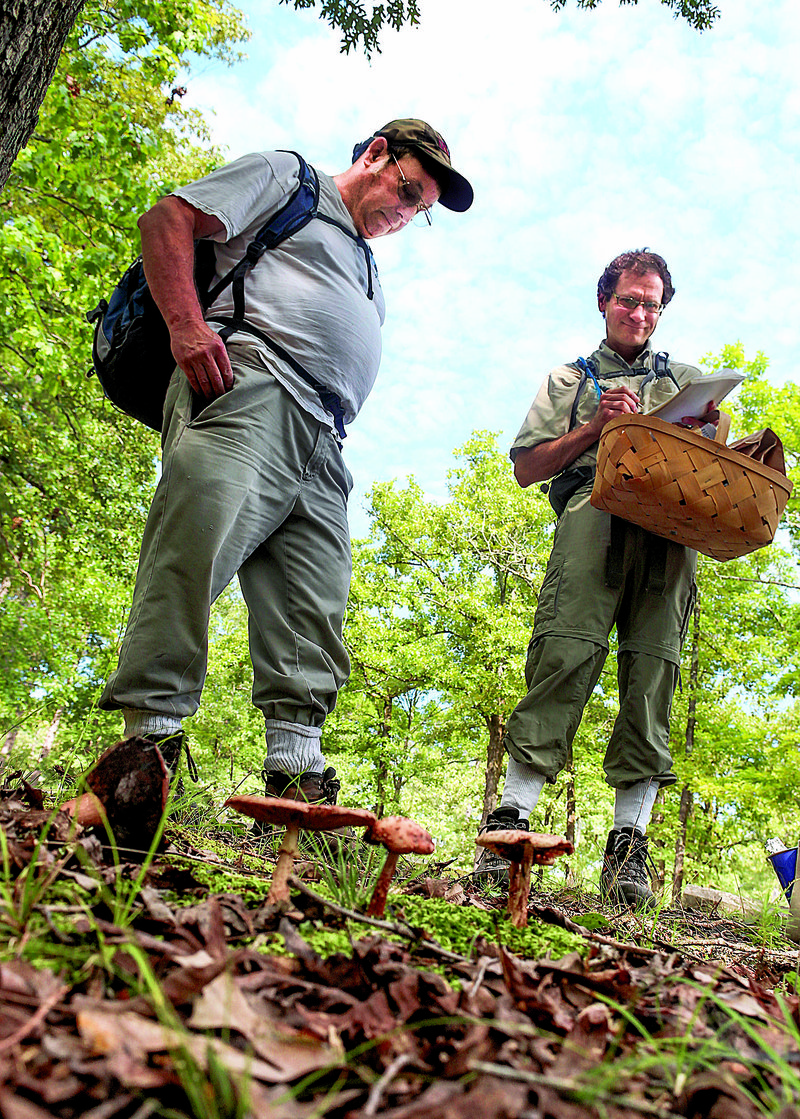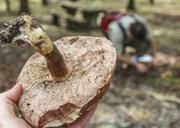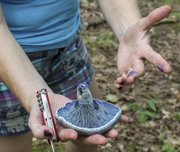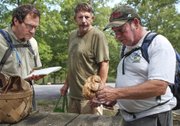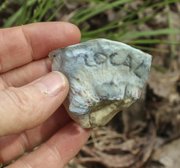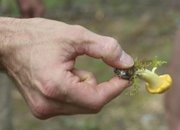PERRY COUNTY -- Imagined dialogue based on preconceived notions about mushroom hunters, written before recent foray:
Visitor: "Can I eat it?"
Expert: "No, fool. The red ones are all pure poison."
Visitor: "What about that one?"
Expert: "Red means dead."
Visitor: "How much longer do we have to walk until we get to the edible ones?"
Expert: "Just another two miles."
Actual dialogue from a foray led Aug. 28 by the Arkansas Mycological Society:
Visitor: "What's that?"
Expert: "Tylopilus. We discussed that earlier. Check your notes if you can't remember. Many of the Boletes, several of the genera, have those white pores when they're young. The Boletus -- like xanthoconium, tylopilus -- will have those white pores also, but as it matures it will take on a pinkish cast. Break the flesh and see what it smells like."
Visitor: "It's got an aroma of ..."
Expert: "Yeah, it does. Some of them smell like stinkbugs. That's a good feature to check on mushrooms. There's one mushroom that smells like mouse urine."
Visitor [to self]: "How do I find out what mouse urine smells like?"
Expert: "Ask a mouse?"
Actually the expert didn't say that last line, but given the chance, he would have. Banter mingled with scientific terminology as this mushroom hunt progressed slowly around 8 or 9 acres of woods within plain sight of the gate into the Lake Sylvia Recreation Area of the Ouachita National Forest, 38 miles west of Little Rock.
Although the hunters were looking for food, more than that they were learning to see, smell, touch, observe things it is a challenge to remember.
The keys to mushroom ID do not appear as simple as "red means dead." In the first place, no, it doesn't. And in the second, different things can look alike. And the same thing can look very different when it's young than when it's old.
This outing on the last weekend of an unusually soggy August was open to all comers, and six well-prepared collectors came (plus one ill-prepped Visitor who read about the foray just that morning on Facebook).
Here's what it was like to show up "cold" to a mushroom hunt -- with bug spray but without reading glasses and without having looked at a glossary, without understanding there are broad groups like Boletes vs. Amanitas, or that Amanitas include some notoriously toxic types:
Visitor stops at the unmanned fee box, gets out of the car clutching $3 and fails to spot the clearly labeled slot for the fee envelope.
A lone car is parked in a small strip 20 feet away, with a door open. Five people stand farther away, in the shade. They do not look, from their clothing, like a group. Outfits range from tank tops and shorts to a ready-for-the-Outback ensemble including vented shirt tucked into zipper-leg cargo pants with ankles rolled to reveal tick-stopping white knee socks.
"Anybody know where the fee goes?"
Gopher-like, beside the car he's unpacking, up pops Jay Justice, founding member of the Arkansas Mycological Society and acknowledged expert mushroom-ID guy.
Visitor: "Have you seen a group of hikers around here? Maybe talking about mushrooms?"
"No, but that's who we are supposed to be," Justice laughs, ducking out of sight.
Closer inspection finds him squatting beside a long basket with what could be blue plastic drinking cups clipped along the sides. It's not his good collection case. He doesn't want anyone to model theirs after it. Stop looking in there.
He's also wearing cargo pants and white socks, but the blending effect of his brown camo ball cap is somewhat wrecked by the words "Arkansas" and "Hogs" in blazingly uncamouflaged red.
He shakes hands warmly and then, strapping a backpack on and hitching up his pants, he leads the way to the group, who seem to know one another.
A quick exchange of plans, and everyone hikes across the entry road to an unremarkable-looking patch of dirt below oaks and hickories.
Suddenly, mushrooms are everywhere. Everywhere.
WONDERS
Visitor: "Holy cats! Is that why you chose Lake Sylvia for today? You spotted all the mushrooms in this little area?"
Justice: "No. I picked this out as a good location for forays because it's public land, and we don't get shot at in the fall."
Kent Zocchi: "Cutting them is legal in the national forest, for personal use."
Zocchi, a Little Rock retinologist, appears bent upon cataloging the fungal genera at Sylvia. Sometimes checking with Justice to confirm scientific names or collect an anecdote from his ready supply, Zocchi crouches over a spiral-bound notebook and scribbles in longhand. Then he places a mushroom beside his writing and takes its photo with his phone.
Four other people scatter toward Perry County 58. They step about the forest with their chins tucked. Sharp-eyed, they also carry sharp knives. (Justice has an iridescent pink, purple and blue carbon blade that's wicked sharp.) A millennial-looking man and woman soon venture out of view; but Paul and Melanie Norris, baby boomers recently returned to Arkansas after 15 years in the Pacific Northwest, circle back to Justice often.
Melanie Norris gathers yellow-orange chanterelles, which are edible and recognizable enough with only two look-alikes to rule out. She finds large stands of easily overlooked, delicate black trumpets, also edible. She finds an indigo milkcap, a thick umbrella that looks like pale blue insulation foam but oozes startlingly inky "milk" when cut. The ink travels from her hands to the tip of her nose.
Paul Norris confides that although he started hunting wild mushrooms "13 or 14 years ago," he spent at least three years learning before he felt brave enough to eat what he picked. Unfortunately, the mushrooms of Washington state are not the mushrooms of Arkansas -- even though they look like they ought to be. "The Boletes -- they're just so many here," he says. "We have five or six in the Northwest. There's one or two that you can't eat, but everything else, you're good."
Not so in Arkansas. Many of the things he'd expect to take home here would be edible but too bitter to bother with.
AND THERE ARE BUGS
Paul Norris: "I am not eating that."
Visitor: "Are they edible or not?"
Norris, Zocchi and Justice: "Yes."
Visitor: "Why don't you want it then?"
Paul Norris: "Feel the stalk, feel how mushy. You have to beat the bugs to the good ones in Arkansas."
Birds don't eat mushrooms, Justice says, but insects and deer, turtles, slugs and snails do. Squirrels are picky, favoring some but not others, even some Amanitas.
Also, fungi eat fungi. The mushrooms that pop up to spread the spores of organisms living deeper in the soil and out of sight can be attacked and digested by airborne fungi. Some of these improve the taste of mushrooms that otherwise would be too bitter to eat, Zocchi says.
GOOD MEMORY, BETTER NOTES
Making his entry on a mushroom identified as Boletus pallidus ("pale Boletus"), Zocchi notes that it changes color quickly when touched.
"A lot of them bruise, but this one has the exception that it bruises blue, which in America, usually, from a Boletus point of view, indicates something you shouldn't eat," he says. "But this one bruises blue, but it is edible."
Later on he takes a whitish gray, uninteresting-to-the-uninitiated mushroom to Justice for inspection.
Zocchi: "Is this an Amanita of some type?"
Justice: "That could be spreta, the 'Hated Amanita.' I don't know why it would be so hated. Hmm. It doesn't have the bulbous base; it has the sacate volva, and it has an annulus on there. I have some of those in my yard."
Zocchi: "That's one of those where if you don't wait until it's mature, you might not be able to tell that it actually has gills. Looking at this you might think those could be gills. But this could kill ya. Try to stay away from being killed."
"I think, 'Don't eat the mushroom,' that's definitely a good rule of thumb," Zocchi says.
"Don't eat the mushroom unless you know all the characteristics and are keeping in mind that just the way it looks is not enough to tell. Some have look-alikes. There's three or four that look pretty similar but they're not, and one will kill you: That one's tasty, this one's not so good, that one will just give you a stomachache.
"It's good to be really cautious. That's why hanging out with a guy like Jay, who just knows a million different mushrooms, is the way to go."
By his own estimate, Justice has spent "at least 36 years" identifying fungi in Arkansas. He retired in 2011 from the Arkansas Department of Environmental Quality after 27 years as a chemist in the technical services branch and nine years as an epidemiologist in the air division. His master's degree (from the University of Arkansas) was in natural sciences, but his bachelor's was in chemistry.
"The trigger that got me interested in mushrooms was actually the deadly toxins in the Amanitas," he says. "At the time I was studying several plant toxins, and I found these mushroom toxins very intriguing because they were polypeptides and did not denature or change shape when the mushrooms were cooked -- but instead stayed virulent. I took a survey course in mycology in 1977, my first semester of graduate school."
In 1980, he and a retired high school history teacher, Edith Nelson, joined the North American Mycological Association and gave a little program about mushrooms at Pinnacle Mountain State Park that inspired three other people to join them in founding the Arkansas Mycological Society. (Nelson died in 2004.)
SORE LEGS
Mushroom observation might be a stealth form of body-weight boot camp: stand up, squat down, stand up, squat down ... for two hours.
Justice walks less than everyone else, because they constantly double back to bring him a question.
For the most part, the question isn't "Should I eat it?" but rather, "How do I know?"
Noticing color, shape, size, form and where the fungus grows in relation to trees are keys. But not the only keys. Mushroom hunters pour or dab chemicals on fungi to check how they react. They leave the caps on clear glass or paper and check the color of the spores that eventually fall or shoot out.
And then there's DNA analysis. But not in the recreation area.
Peering at a questionable item in Melanie Norris' hand, Justice furrows his brow. She wonders if it might be a particular Bolete she knows from Washington state.
Justice: "See those pore layers? Those are different."
Paul Norris: "It's bruising different, too. It's brown. It's a darker color."
Melanie Norris: "Is that from age?"
Justice: "No, that's genetic expression. ... OK, I don't know what it is, so just put it back. It's a Bolete, we know that.
"But seriously, I am not sure."
See "Mushroom Mania" photo gallery at
arkansasonline.com/galleries
ActiveStyle on 09/19/2016
